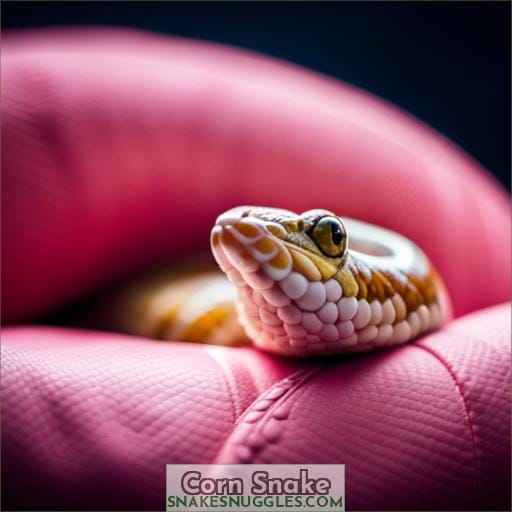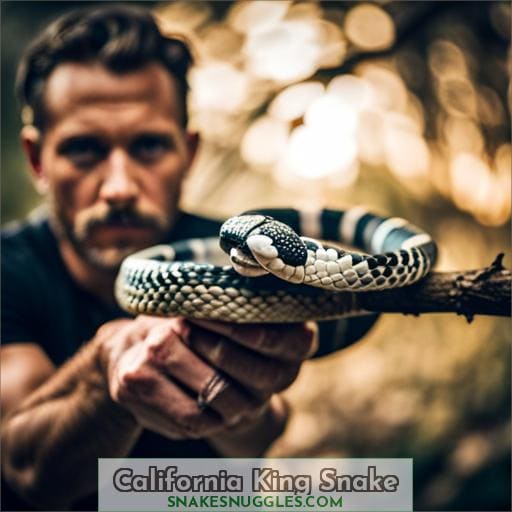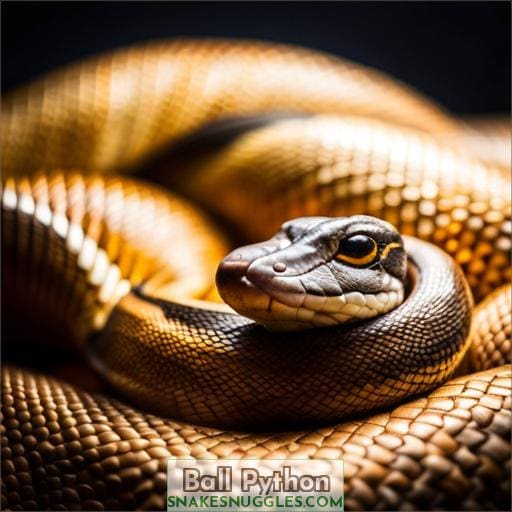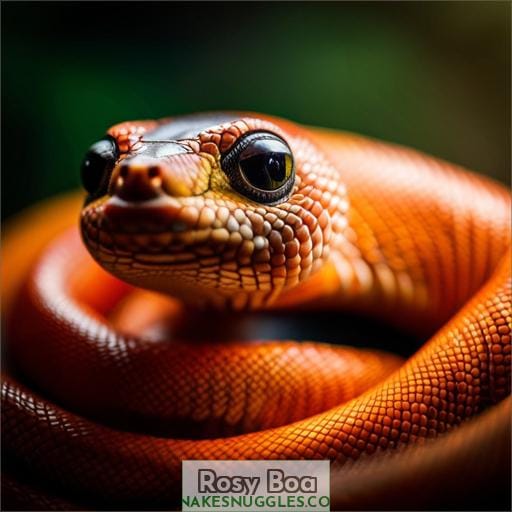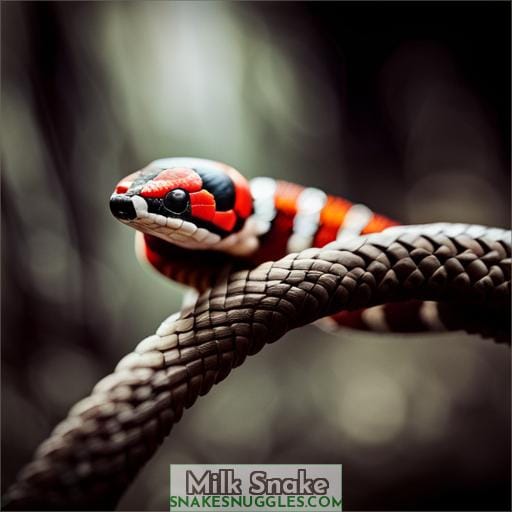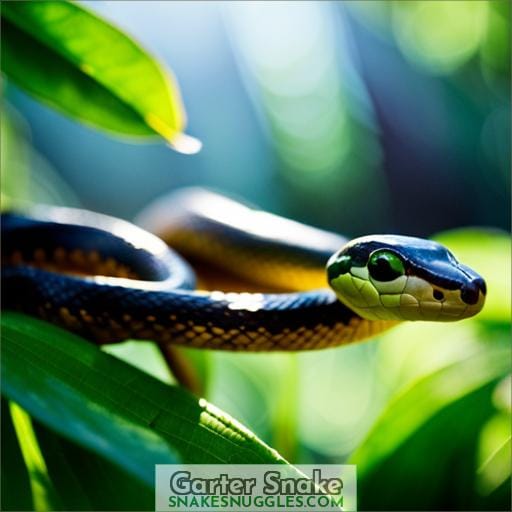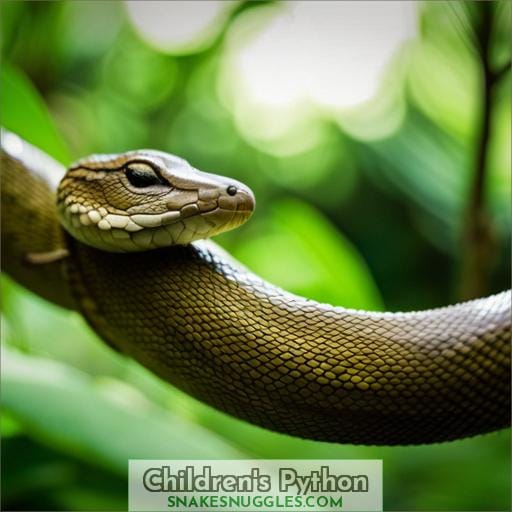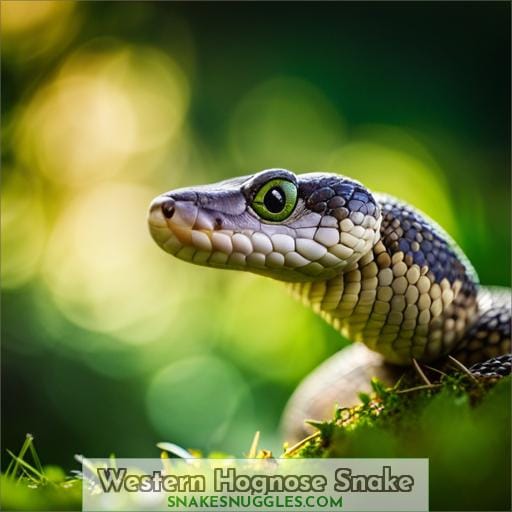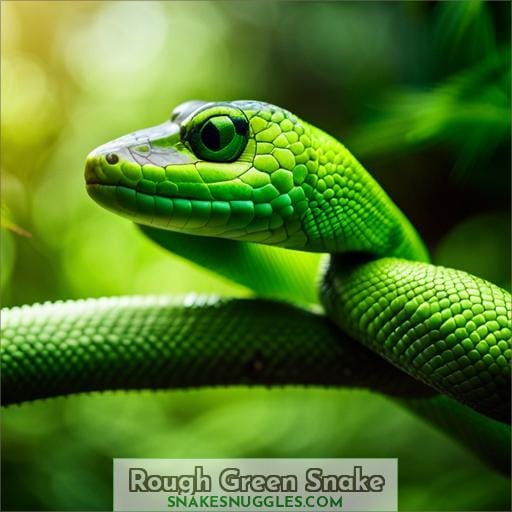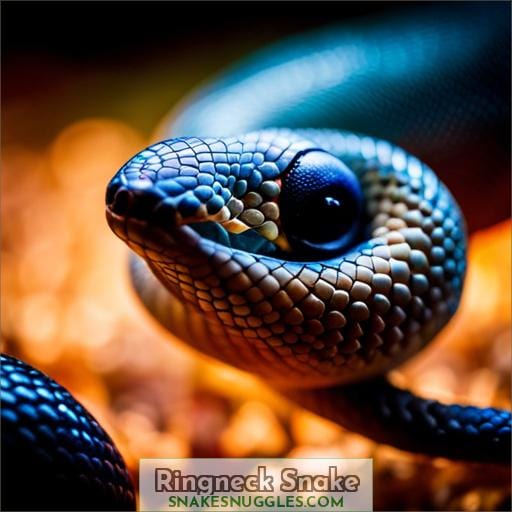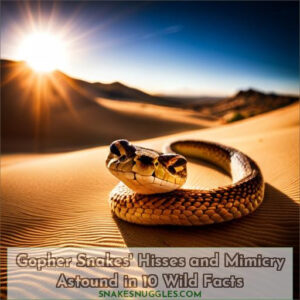This site is supported by our readers. We may earn a commission, at no cost to you, if you purchase through links.
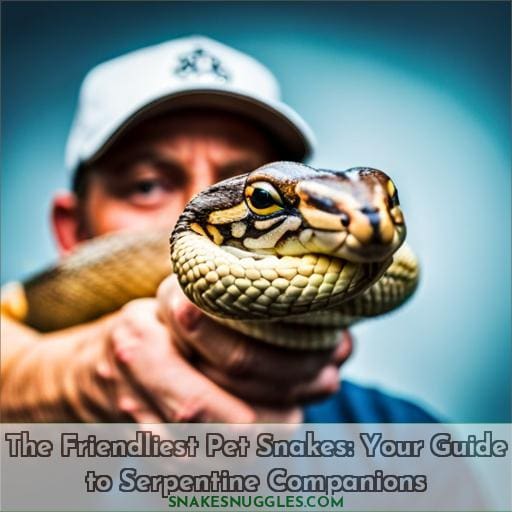 Imagine having a pet snake that’s not only fascinating, but also friendly and easy to care for.
Imagine having a pet snake that’s not only fascinating, but also friendly and easy to care for.
In this article, we’ll introduce you to the top 10 friendliest pet snakes out there. From the docile Corn Snake to the charming California King Snake, each species has its own unique qualities that make them perfect for beginners or experienced reptile enthusiasts alike.
Get ready to discover your new scaly best friend!
Table Of Contents
Key Takeaways
- Corn snakes are docile and easy to care for.
- California king snakes are active and inquisitive.
- Ball pythons are calm and gentle.
- Rosy boas are relaxed and friendly.
Corn Snake
When considering a friendly and easy-to-care-for snake companion, the Corn Snake stands out as an excellent choice for you.
With a docile temperament and straightforward care requirements, Corn Snakes make ideal reptilian friends.
Delving into Corn Snake genetics can reveal captivating color variations, adding a touch of uniqueness to your serpent companion.
Enrichment activities, such as climbing structures and hiding spots, cater to their natural behaviors, promoting both physical and mental well-being.
If you ever contemplate breeding, understanding Corn Snake breeding considerations ensures a responsible approach to their reproductive health.
Health checklists become invaluable tools in maintaining your snake’s well-being, emphasizing regular veterinary visits and vigilance.
Crafting a habitat that mimics their natural environment further enhances their comfort, making the Corn Snake a delightful and engaging addition to your home.
California King Snake
If you’re considering a friendly and easily manageable pet snake, the California King Snake stands out as an excellent choice for enthusiasts of all levels. With their docile temperament, beautiful coloration, and varied diet, these snakes make excellent companions for both beginners and experienced snake owners alike.
Benefits of owning a California King Snake:
- Easy to care for: California King Snakes are relatively low-maintenance pets that require a basic understanding of snake care.
- Docile temperament: California King Snakes are generally docile snakes that are easy to handle and interact with.
- Varied diet: California King Snakes are adaptable eaters that will readily accept a variety of prey items, including mice, rats, and small birds.
Ball Python
Moving on to the next friendly pet snake, let’s talk about the Ball Python.
Known for its popularity and gentle demeanor, Ball Pythons thrive in controlled enclosures with ambient temperatures around 78-80°F and a basking spot of 88-92°F. They exhibit interesting behavioral quirks, often curling into tight balls when stressed or feeling vulnerable.
Regarding diet, these constrictors prefer small mammals like mice or rats, consuming them whole. Maintaining adequate humidity between 50-60% is crucial, especially during shedding, which occurs every 4-6 weeks.
Ball Pythons, cherished for their calm disposition, make excellent pets, requiring minimal handling and offering a fascinating glimpse into the world of captivating snake personalities.
Rosy Boa
Navigating through the diversity of snake companions, you’ll find the Rosy Boa to be a charming addition to your serpent-loving household.
Known for its unique patterns blending brown, white, and rosy pink hues, this species captivates with its docile demeanor and manageable size of up to 4 feet.
Enrich their habitat with climbing structures, hiding spots, and plants for their comfort.
Handling techniques involve gentle approaches due to their calm nature, fostering intimacy between owner and pet.
Expect a lifespan of up to 25 years, making the Rosy Boa a long-term companion.
Breeding considerations revolve around controlled temperatures and mating compatibility.
With its distinctive markings and ease of care, the Rosy Boa stands as an appealing choice among pet snakes.
Milk Snake
Milk Snakes exhibit diverse color patterns, making them captivating choices for novice reptile enthusiasts.
- Color Variations: Showcasing vibrant rings or bands in red, black, and yellow, resembling the venomous coral snake.
- Cannibalism Behavior: They may display cannibalistic tendencies, warranting separate enclosures for multiple milk snakes.
- Habitat Preferences: Preferring semi-arid environments, they thrive in terrariums with hiding spots and moderate humidity.
- Lifespan Expectations: With proper care, these snakes can live up to 20 years, offering long-term companionship.
Understanding their diverse feeding habits, habitat needs, and intriguing color patterns makes caring for milk snakes an engaging and rewarding experience for aspiring snake owners.
Garter Snake
Transitioning from the vivid patterns of the Milk Snake, the Garter Snake emerges as a testament to adaptability and ubiquity. In natural habitats spanning North America, their population distribution echoes their resilience.
Garter snakes, known for their slender bodies and varied colors, manifest predatory behavior, relishing small fish, worms, and amphibians. Their habitat preferences encompass diverse landscapes, from woodlands to grasslands.
Environmental enrichment for these serpentine companions involves ample hiding spots and climbing structures. Reproductive habits are notable; females produce live young after mating, reflecting the intimacy of their life cycle.
Garter snakes offer a captivating glimpse into snake socialization, thriving in communal hibernation sites.
Reptile husbandry involves mimicking their wild settings, ensuring a liberated, empowered, and contented companion.
| Emotional Liberation | Empowered Environment |
|---|---|
| Curiosity piqued | Abundant hideouts and climbs |
| Connectedness to nature | Diverse habitat simulation |
| Intimate understanding | Communal hibernation sites |
Children’s Python
As we delve into the captivating world of Children’s Pythons, embrace their Australian habitat, fostering a unique blend of warmth and security essential for their well-being.
Witness their intriguing reproductive behavior, marked by maternal incubation, fostering a deeper understanding of their nurturing instincts.
Enrich their environment with climbing apparatus, hiding spots, and foliage, encouraging their natural curiosity and exploratory nature.
Embrace their dietary variations, relishing in their preference for mice or rats, ensuring a balanced and fulfilling diet.
Master handling techniques to foster intimacy, encouraging trust and confidence between you and your Children’s Python, establishing a bond that transcends mere companionship among snake species.
Western Hognose Snake
Explore the Western Hognose Snake‘s captivating traits and behaviors, making it an intriguing companion for reptile enthusiasts.
This species exhibits distinctive feeding habits, favoring toads and occasionally rodents. Their habitat preferences lean towards sandy environments, mimicking their native plains.
Western Hognose Snakes showcase unique behavioral traits, such as their infamous playing dead defense mechanism, hissing, and bluff striking when threatened.
Captive breeding has expanded their availability in the pet trade, contributing to their popularity among snake keepers. Their moderate size, around 4-5 feet, and manageable temperament make them appealing choices for those seeking engaging and manageable reptile pets.
Understanding their quirky behaviors and providing a safe, suitable habitat ensures an enriching experience with these captivating serpentine companions.
Rough Green Snake
Discover why the Rough Green Snake stands out for its adaptability and low-maintenance care among pet enthusiasts.
- Arboreal Habitats: Flourishing in trees, these snakes thrive in vertically arranged terrariums with branches for climbing.
- Dietary Preferences: They exclusively consume insects and spiders, requiring live prey, which adds complexity to their care.
- Environmental Enrichment: Mimicking their natural habitat is crucial; providing foliage and hiding spots aids in reducing stress and promotes their well-being.
These snakes, though captivating with their slender bodies and vibrant green hue, demand specific conditions, making them better suited for experienced handlers. While their ease of escape and specific dietary needs may pose challenges, their captivating presence and unique arboreal behaviors offer an intimate insight into the captivating world of these delicate serpents.
Ringneck Snake
Ringneck Snakes, often mistaken for their more venomous counterparts, continue to captivate snake enthusiasts with their striking appearance and relatively harmless nature. Among the spectrum of pet snakes, these diminutive creatures surprise many due to their vivid collar-like orange rings, making them an intriguing choice for hobbyists seeking a visually appealing and docile companion.
Ringneck Snakes display colorful patterns that vary from region to region but generally consist of a dark gray or black body adorned with bright orange or yellow bands encircling its neck. They primarily feed on earthworms and small amphibians found in their natural habitat which includes woodlands, grassy areas near water sources such as streams or ponds.
It’s important to note that despite popular misconceptions about venomous capabilities based on the name Ringneck, these snakes are non-venomous and pose no threat to humans or other larger animals they encounter.
Furthermore, Ringneck Snakes play an essential role in controlling populations of insects, reptiles, and rodents, making them ecologically important members of various ecosystems.
Frequently Asked Questions (FAQs)
What are some of the best beginner-friendly snakes?
If you’re a beginner looking for a pet snake, some of the best options include:
- Corn snakes
- California kingsnakes
- Ball pythons
- Rosy boas
- Milk snakes
What are some of the most popular pet snakes?
You are looking for a popular pet snake?
The most popular pet snakes include:
- Ball python
- Corn snake
- California kingsnake
- Rosy boa
- Milk snake
What are some of the most unique snakes?
Some of the most unique snakes include:
- The milk snake
- The hognose snake
- The rough green snake
These snakes are all non-venomous and have distinct markings or behaviors that make them stand out from other snakes.
What are some of the things to consider when choosing a snake as a pet?
When choosing a snake as a pet, there are many factors to consider, such as:
- The snake’s size
- The snake’s temperament
- The snake’s care requirements
What are some of the challenges of owning a snake?
There are several challenges to owning a snake, including:
- The need for specialized care
- The potential for escape
- The possibility of bites
Conclusion
Embarking on the journey of serpentine companionship promises a captivating experience with an array of friendly pet snakes.
Picture this: Envision yourself mesmerized by the gentle nature of a Corn Snake or enchanted by the charm of a California King Snake.
These reptilian companions, from the resilient Ball Python to the slender Ringneck Snake, offer a diverse range of qualities.
Choosing the friendliest pet snake is an exciting venture, and this guide serves as your roadmap to fostering a unique bond with these scaly wonders.

